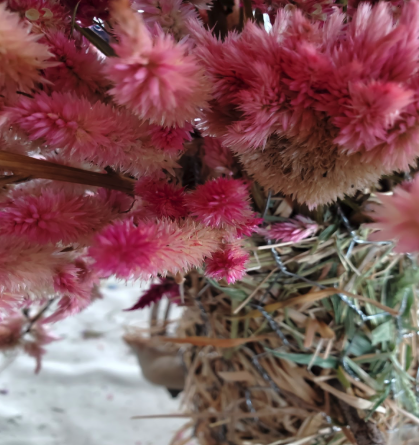Omaha's Guide to Sustainable Floristry
Sustainability in floristry goes beyond beautiful arrangements—it’s about honoring the planet while creating lasting impressions. Holly Lukasiewicz, founder of District 2 Floral Studio, has proven that with the right practices, floristry can be both stunning and sustainable. Here’s how you can follow her eco-friendly approach to make a difference in your work and community.
Source Locally and Seasonally
Support local farmers by prioritizing flowers grown nearby. This reduces your carbon footprint and supports local farming.
Partner with local farm collectives like Flatland Floral Collective to access seasonal, locally grown flora. For off-seasons, use dried flora or flowers sourced from domestic growers. It’s essential to build relationships with local farmers and wholesale suppliers to ensure transparency in growing conditions.
Why It Matters: Locally grown flowers minimize the environmental toll of transportation and refrigeration while supporting local economies.
Photo: Buckets of fresh, locally grown flowers sourced from Big Muddy Urban Farm (Omaha, NE). Photo by District 2 Floral.
Look for certifications like:
Certified American Grown to ensure ethical domestic sourcing.
Rainforest Alliance Certified for international growers prioritizing sustainable and fair labor practices.
Skip Floral Foam
Avoid single-use floral foam, which breaks down into microplastics harmful to ecosystems.
Embrace natural alternatives like chicken wire, moss, Oshun Pouch, Agra Wool, or bio-based PHOAM. These are reusable, commercially compostable and safer for the environment.
Why It Matters: By skipping foam, you reduce non-compostable biodegradable waste while adopting innovative techniques for sustainable design.
Photo: Bricks of green “Oasis” foam and gray foam taped to a plastic tray, used as a structural design element. Captured after the floral arrangement was disassembled during a traditional floral design school course (2021).
Various examples of "grass burritos"—reusable chicken wire wrapped around dried grass and leaves—serve as a sustainable alternative to floral foam (Oasis). A floral staircase was constructed using this technique (2023).. Here’s a “grass burrito how-to” from District 2 Floral.
Compost Floral Waste
Create a composting system to dispose of stems, foliage, and floral scraps.
Collaborate with local commercial composting services like Hillside Solutions Compost Club to turn waste into nutrient-rich compost.
Avoid using flowers treated with dyes, glitter, or bleach, as they cannot be composted.
Why It Matters: Composting transforms floral waste into a resource that supports soil health, local farming and reduces landfill impact.
And other Waste Management Systems
A clear waste management system reduces landfill contributions and ensures materials are reused or repurposed effectively.
Find a few bins to sort your items by waste. Use a compost bin for stems and foliage. A reuse bin for materials like paper wraps, plastic bags, and rubber bands (to be used again in future projects). Use a recycle bin for metal and plastic containers, paper and cardboard. The Hefty Renew Bag excepts soft, hard to recycle plastics, like torn bouquet wraps. A landfill bin captures everything else.
Don’t have recycling or composting services? Email Samantha at samantha@hillside.solutions. She can help set that up for you!
Read more here from District 2 Floral.
District 2 Floral Studio utilizes a five-bin waste management system, which includes a compost bin (processed through Hillside Solutions Compost Club), reusable plastics bin, recycle bin, ReNew "orange" bin, and a landfill bin(effective June 2024).
Educate Your Clients
Include an ingredient list with each arrangement to show transparency about flower sourcing and inspire thoughtful purchasing.
Share your sustainable practices on your website, social media platforms, and through workshops.
Why It Matters: Educating clients empowers them to make eco-conscious decisions and supports the shift toward sustainability in the industry.
Photo: Branch Cloud installation in a home, designed by District 2 Floral Studio using locally sourced natural elements. Photo by District 2 Floral (June 2022).
Reduce packaging waste
Use compostable materials like paper wraps, plant-dyed ribbons, and natural fiber ties.
Reuse rubber bands, flower boxes, and plastic wraps again wherever possible.
Recycle materials that can’t be reused through municipal recycling programs or ReNew orange bags for hard-to-recycle plastics.
Skip single-use plastics like floral picks, synthetic ribbons, and balloons.
Cutting and placing tension stems in a vessel before beginning a design is another sustainable option in place of foam. (Oasis, 2024).
Why It Matters: Reducing and reusing packaging minimizes landfill waste and your environmental footprint and sets a positive example for clients.
Photo: Using tension stems in a vessel before starting a design provides a sustainable alternative to floral foam (Oasis). Photo by District 2 Floral (2024).
Reuse post-event florals
Partner with organizations like Second Chance Bouquets to give event florals a second life.
For example, in Feb 2021, District 2 Floral Studio transformed hundreds of rescued, landfill-bound roses into an installation within Leslie Iwai’s “community Sounding Song sculptures - highlighting beauty in imperfection and waste.
Additionally, it’s a good idea to offer clients creative reuse options up front, such as repurposing arrangements or preserving flowers.
Why It Matters: Reusing flowers reduces waste and adds meaning to arrangements, extending their beauty and purpose.
Photo: A flower installation by District 2 Floral Studio within Leslie Iwai’s "Community" Sounding Stone sculpture in Omaha, NE (Feb. 2021). Part of a series of installations, it was created by rescuing hundreds of landfill-bound roses discarded after Valentine’s Day by a big-box chain florist. The project examined our perception of beauty, highlighting how imperfection and waste can still hold value. Photo by District 2 Floral.
Avoid synthetically dyed flowers
Synthetically painted flowers should be avoided because their paints often contain chemicals that can leach into soil and water, hinder biodegradation, and pose health risks.
The production process is energy-intensive and relies on non-renewable resources, making it less sustainable.
Photo: Synthetically dyed and painted pussy willow tips, captured by District 2 Floral at a local wholesaler (2022).
Stay Inspired with Resources
Read “Flower Confidential” by Amy Stewart – A deep dive into the global floral industry, or “Braiding Sweetgrass” by Robin Wall Kimmerer – A reflection on our relationship with nature.
Sustainable Floristry Network Introductory Course is a deep dive into understanding sustainability practices as they relate to environmental, social and economics within the global floral industry.
Why It Matters: Continued learning helps you stay informed and inspired, enabling you to lead by example in your industry.
Photo: A flower installation by District 2 Floral Studio inside a garbage bin in Omaha’s Old Market (May 2021). Created to offer a fresh perspective on urban environments, the piece prompted reflection on what we value, where we place that value, and how it is expressed. All flora was locally sourced.
Embrace Progress Over Perfection
Did you know bleaching baby’s breath involves using harsh chemicals that can leach into soil and waterways? Most may not! That’s okay. Through education, folks will become more aware.
Sustainability is a journey. Start with small, manageable changes and build from there. Holly’s mantra reminds us: “Every little step makes an impact.”
By adopting these practices, florists can reduce landfill waste, support local farmers, and offer clients exquisite designs while advocating for nature’s well-being.
Photo: Artificially bleached baby’s breath (gypsophila) and sedum, captured by District 2 Floral at a local craft store (2022).
Join sustainable communities
Connect with like-minded professionals through the Slow Flowers Society.
Take courses with the Sustainable Floristry Network to deepen your understanding of eco-friendly practices.
Why It Matters: Collaboration and education are key to driving change and staying motivated in your sustainability journey.
Photo: Hen and the Hawk Flower Farm, a specialty-cut flower farm in Fort Calhoun, NE. Photography by Kamrin Baker Creative.
















